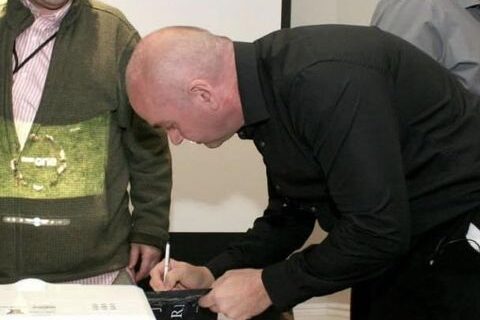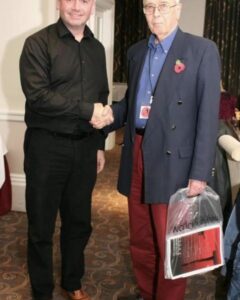A Historic Encounter: Russell Edwards meets Neville Swanson to Discuss Jack the Ripper’s Identity
In 2014, author and researcher Russell Edwards found himself at the center of a breakthrough moment in the Jack the Ripper case. Edwards, whose dedication to uncovering the true identity of the Whitechapel killer led him to years of forensic analysis and painstaking historical research, met with Neville Swanson, the great-grandson of Donald Swanson, one of the original detectives on the Ripper case. This fateful meeting brought together two individuals connected by a shared goal and, as it turned out, a shared theory that could close one of history’s most haunting cases.
The Connection to Donald Swanson
Donald Swanson served as Chief Inspector in the Metropolitan Police during the late 19th century and was closely involved in the investigation of the Jack the Ripper murders. Swanson’s meticulous notes on the case, recorded in his personal copy of The Lighter Side of My Official Life by Sir Robert Anderson, contain an explosive revelation: Swanson identified Aaron Kosminski, a Polish immigrant and barber living in Whitechapel, as the primary suspect in the Ripper murders. Swanson’s marginalia clearly name Kosminski and detail how the police considered him mentally unstable and a likely culprit. However, due to a lack of definitive evidence and legal constraints, they were unable to convict him.
These notes, kept within the Swanson family, became a pivotal piece of historical evidence when they were shared with the public. They provided invaluable insight into the police’s suspicions, which were otherwise hidden from official case files. Donald Swanson’s private annotations provided a rare inside look at the thoughts of one of the top detectives on the Ripper case.
Russell Edwards’ Journey to Solve the Mystery
Russell Edwards was captivated by the Jack the Ripper mystery for years, convinced that modern forensic science might finally solve the case. His journey led him to the acquisition of a shawl believed to have been found at the murder site of Catherine Eddowes, the Ripper’s fourth canonical victim. Edwards had the shawl analyzed, hoping it contained forensic evidence that could identify the killer.
In collaboration with genetic scientists, Edwards arranged for DNA testing on samples from the shawl. The analysis eventually yielded mitochondrial DNA that Edwards claims matched descendants of both Catherine Eddowes and Aaron Kosminski, pointing to Kosminski as the likely killer. The findings were controversial but represented the most substantial lead in years.
The Meeting of Minds: Russell Edwards and Neville Swanson
When Edwards met Neville Swanson, it was more than just a historical curiosity—it was a convergence of past and present investigations, uniting the work of a 19th-century detective and the findings of a modern-day researcher. Neville Swanson, as the great-grandson of Donald Swanson, carried with him not only the legacy of his family’s connection to the case but also a deep personal interest in uncovering the truth. This meeting allowed both men to exchange insights and compare the findings of Edwards’ forensic research with Donald Swanson’s 19th-century suspicions.
For Edwards, meeting Neville Swanson was a powerful confirmation of his own research. Swanson’s great-grandfather had come to the same conclusion over a century ago based on witness statements and investigative experience, identifying Kosminski as the prime suspect. Edwards’ DNA findings appeared to affirm what Donald Swanson suspected all along—that Aaron Kosminski was indeed the man responsible for the Whitechapel murders.
Why This Meeting Matters
This encounter between Edwards and Swanson was symbolic of the enduring dedication to solving the mystery of Jack the Ripper. Edwards’ forensic evidence, combined with Donald Swanson’s century-old notes, formed a rare fusion of historical police insight and modern scientific verification. Their joint theory—that Kosminski was the Ripper—gained new credibility through this meeting, as it effectively bridged two eras of investigation.
Both men’s commitment to this case underscores an essential message: that Jack the Ripper’s victims deserve justice and remembrance. Neville Swanson, in carrying on his great-grandfather’s legacy, became an ambassador of sorts for the victims and for the Swanson family’s historical role in the investigation. For Edwards, the meeting served as a moral and scientific validation of his work, helping to further his mission to bring closure to the case.
The Legacy of the Edwards-Swanson Meeting
Though Edwards’ findings have stirred debate, his meeting with Neville Swanson solidified the theory that Aaron Kosminski was Jack the Ripper in the eyes of many. Edwards’ 2014 book, Naming Jack the Ripper, details this journey, explaining both the scientific evidence he uncovered and the historical insights provided by his meeting with Swanson.
This meeting also helped shift the public’s focus from Jack the Ripper as a sensational figure to the lives of the people impacted by his crimes. Edwards has worked since then to honor the Ripper’s victims, commissioning blue plaques for each of the canonical five women to memorialize their lives rather than just the horror of their deaths. This symbolic gesture ties into the legacy left by Donald Swanson’s notes, which expressed a deep concern with finding justice for the victims.
Conclusion: Two Eras, One Truth
The 2014 meeting between Russell Edwards and Neville Swanson was more than a simple interview or chance encounter—it was a unification of two lifetimes of dedication, driven by the need to solve a century-old mystery and bring peace to those affected by it. By combining Donald Swanson’s insights with Russell Edwards’ forensic research, this meeting stands as a pivotal moment in Ripperology, one that may finally answer the question of Jack the Ripper’s identity and provide a lasting, respectful memorial for his victims.
As new evidence and theories continue to emerge, the legacy of the Edwards-Swanson meeting endures as a testament to the tireless pursuit of truth.
Book your your with Russell Edwards here







